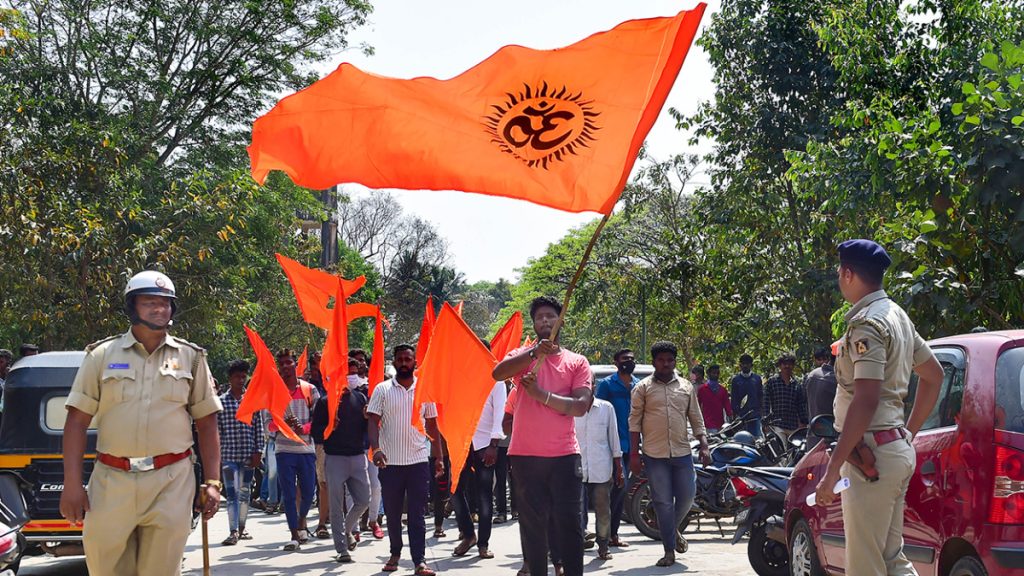Rallying around religion
India: ‘communalizing the country’. Het manipuleren van religie en van religieuze minderheden zondebokken maken, is een beproefde tactiek van de nationalistische hindupartij BJP, die sinds enkele jaren aan de macht is in India. “Religie wordt politiek gebruikt en misbruikt”, is dan ook de stelling van Ashok Gladston Xavier, geassocieerd hoogleraar Social Work, aan het Loyola College in Chennai.
In feite zijn het de BJP-ideologen die bewust (religieuze) conflicten creëren om aan de macht te blijven. “Agressieve campagnes, pogingen om bepaalde gemeenschappen door een haatpolitiek te mobiliseren, ondersteunen voortdurend de politieke agenda’s om conflicten uit te lokken”, schrijft Ashok.
De laatste maanden waren er in India twee ‘incidenten’ die Ashoks stelling op een aangrijpende manier illustreren. Een 17-jarig hindumeisje pleegde zelfmoord. Door de BJP werd rondgebazuind dat haar katholieke school druk uitoefende om haar te bekeren. De feiten haalden dit discours helemaal onderuit.
Plots werden ook meisjes lastiggevallen die een hijab droegen. Ze werden gemolesteerd door hindujongeren met oranje sjaals die ‘Jai Shree Ram’ riepen. De meisjes antwoordden met ‘Allah ho Akbar’. Een voorbereidend opleidingsinstituut in Shivamogga (deelstaat Karnataka) ging door de rellen die daardoor ontstonden voor drie dagen dicht. Filmpjes werden via sociale media over het hele land verspreid en hitsten de gemoederen nog verder op. Welke kant gaat India op?
We publiceren hieronder de integrale Engelse tekst van prof. Ashok.

Religion is a tent under which many take refuge. It is often a place to go for all human sufferings. It seems to offer solace to those who are poor, needy hungry and greedy. As much as it provides a sense of security and Identity, it also remains as a very sensitive issue.
Owing to the wide scope of interpretation that is innate to religions based on the texts, ideologies and dogmas they seek to promote, it either updates and co-opts to suit the context or it remains frozen in the time of their prophets and formators.
Religion, apart from serving as a mechanism that provides peace also tends to be the repository of social morality and at times serves as merely a mode of social control. Anything in the name of religion is seen as if it has divine approval to adjudicate on all matters concerning life. Fatalism, superstition and faith without reason continue to blind positive choices and worse, it encourages negative choices at times.
Being a sensitive issue, religion becomes an effortless rallying point to build a negative convergence to meet attain political objectives. In order to survive it has been used by regimes in power and those who aspire for it as well. Oppression and dominance in the name of religion needs no consensus or approval from any government it only needs a nod from the idealogues. In fact, it is the idealogues who craft the plan to create conflict to stay in power.
An easy way to court reactions is to stimulate others to react. It can be throwing a piece of pork inside a mosque, desecrating religious symbols, or mocking religious practices. These provocations combined with customary biases remain instrumental in stereotyping a community as desired.
The dividers have a clear agenda to use all means to spread hatred and keep the communities from coming together. Their ultimate aim to capture power that will enable them to create policies that are further divisive.
Once the power is captured, they learn that they had promised a bit too much to achieve and hence they use micro and mini-incidents to distract the people. The conversation shifts from macro issues to local issues. The aggressive campaigning combined with community mobilization using hate politics tries to keep the entire agenda of nurturing conflict alive.
Two noteworthy incidents that took place in India recently
In the recent months there were two noteworthy incidents that took place in India. First, the death of a school student in Tamil Nadu and second, the ban on Hijab in Karnataka.
In a village in Thanjavur District in Tamil Nadu a 17-year-old girl committed suicide on 15th January 2022. She was a student of a government aided school run by the Franciscan Sisters of the Immaculate Heart of Mary.
Since the girl was observed to be vomiting continuously for a couple of days, the hostel warden had taken her to the district hospital. It was found that she had consumed poison and it had severely affected her kidneys and lungs and she died. Soon a video testimony of her death sprung up accusing the school of forcing the girl to convert to Christianity and as a result she had committed suicide. The state president of the Bharathiya Janata Party (BJP) alleged the coercion to convert to Christianity lead the girl to take this extreme decision. Protests were held to close shut down the school and take stringent action against all concerned. The protests grew bigger and ended up in Chennai.

As soon as the girl died, her father and stepmother had launched a police complaint against the hostel warden Sr Sahayarani (68). She was arrested and remanded.
The Tamil Nadu government had ordered a probe by the District Education Officer who had submitted a 5-page report after due enquiry. The findings of the report were quite revealing. The school had been operational for the past 160 years in the same village. A majority of the students in that school are Hindus.
Lakshmi Subramanian a journalist working with the Week analyzed the situation in her article dated 28th January, “A total of 7,739 students have studied in the school since 2013 till the current academic year. And of them 5,270 are Hindus while 2,290 students are Christians and 179 are Muslims. As per the report, there are 272 boys and 405 girls in the current academic year and of these, 166 boys and 278 girls are from the Hindu community. Apart from the majority Hindu students, there are 219 Christians and 14 Muslim students.”
“We have not received any complaint about forced conversion so far from the students there,” the DEO said in his report. The DEO has also said that “since the majority of students in the school are from other faiths, it has been noted that the headmistress and other teachers did not indulge in giving speeches which are Christian by nature.”
Further enquiry led to revealing findings. The girl’s mother had died about 8 years ago and her father remarried. There have been chronic problems between the stepmother and her for a long time. Since the girl had vitiligo, a skin disease that is visible, caused white patches on her face and fingers, her stepmother used to illtreat her and feared that it would spread to her two children. The girl would not go home even for holidays fearing the ill-treatment.
When the girl came back after the COVID lock down it was found that she had burn injuries on her. She had revealed that her stepmother had caused it. In a previous incident, she had called Childline (the emergency helpline for children). Apparently, the Child line officials had visited the family and enquired about the issue with the parents by her side and she denied any such abuse.
While all this was happening, the BJP started a hate campaign against the Christians. Now a second video was secured. It indicated that there was no conversion angle. Despite the government promising action against the guilty, the protests continued.
In incidents in the towns of Udipi and Shivamogga the state of Karnataka as result of passing the Anti-Conversion law that was recently passed in the state assembly deserved a lot of attention. On 1st of January in a pre-university in Udipi six Muslim girls claimed that they were not allowed to enter the college with their Hijab. They protested and held a press conference. Following, the Hindu youth were mobilized and demanded all the others to wear saffron scarves to the college. This event sparked off a wide protest in the state where Hindu students were crying out “Jai Shree Ram” while the Muslims cried out, “Allah ho Akbar”.

In a pre-university college in Shivamogga, on 7th February, videos of a young student wearing a Hijab heckled by a mob wearing saffron scarves went viral. The men shouting “Jai Shree Ram” and the girl opposing them shouts “Allah ho Akbar” and continues to walk.
The College staff come out and pacify the young men in scarves and try to protect the girl. The protest spreads all across the state, forcing the closure of all pre-university for three days. The matter is referred to the Karnataka High court in which the judge refers it to a larger bench.
In the meantime, the Government of Karnataka uses its Higher Education Act of 1983 and passes law banning clothes that disturbed peace and also mentioned that they institutions should follow a dress code that is prescribed by their respective college development councils. The fact that the most colleges do not have a dress code/uniform at the pre-university level comes as a late realization.

In Karnataka there has been an escalation of protests and even violence in some places. The latest is that a Bajrang Dal (a rightwing organization Hindu organization) cadre was murdered, this has added to further tensions in the state.
The two incidents in South India demand reasonable attention for the following reasons. Karnataka is governed by the BJP. They have tried to implement the agenda of Hindutva for some time now. They used every possible state mechanism to advance their agenda of communalization. They mobilize the youth around the myths about minorities, their rituals and lifestyles.
They try to prove that Hindus are oppressed in the country and there is a need to assert the Hindu religion to survive the Muslim aggression. Quite contrarily, according to Census of India Muslims constitute only 13 per cent of the population of the state, of which the attendance of Muslim women in schools is only 16 per cent as on 2017-18.
In Tamil Nadu the BJP is trying very hard to gain some head way. It has not been easy. Hence, they use such incidents to draw attention and identify the Christians and the Muslims as the major enemies trying to convert people and reduce the Hindu population. According to the census of India 2011, Christians constitute 6.12 per cent and Muslims constitute 5.8 per cent of the Tamil Nadu population.
Using the suicide of the girl studying in a minority institution without any evidence has been a pattern of the communal forces. They portray a picture that the minorities are a threat to the majority Hindu culture. They use a set formula accompanied by a rhetoric that has evolved into a clear pattern.
In states ruled by the BJP, laws are enacted to protect the cow, religious symbols, and passing anti conversion laws and so on. This is seen as clear distraction from dealing with any real socio-economic developmental issue.
Whereas, in states where it aspires to capture power, it mobilizes the youth especially those who are unemployed and less educated around issues like the suicide of the girl in a minority institution.
Not knowing the complete truth, the youth who are fascinated by this newfound identity of belongingness willingly joins the communally toxic campaign that has indoctrinated them. Unable to rationalize the reality, they continue to remain as cogs in the wheel of the grand plan of communalizing the country. Little do they know that they are following the pathways of the Nazis and Fascists that will lead to self-annihilation.
Ashok Gladston Xavier
Ashok Gladstone Xavier is associate professor in social work at Loyola College, Chennai, Tamil Nadu, India





